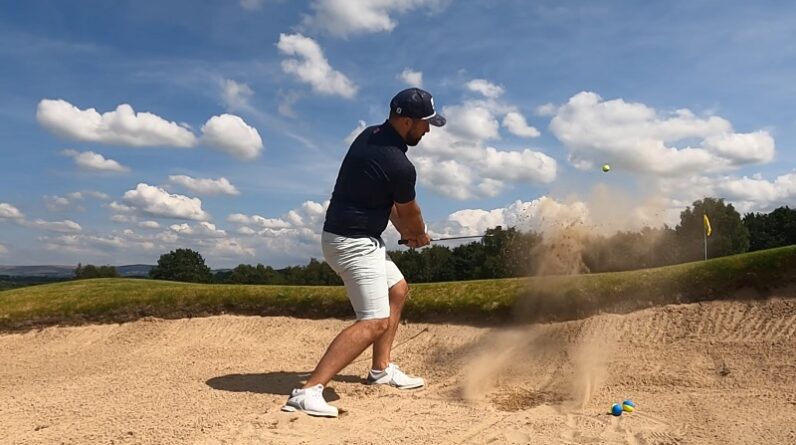Have you ever wondered what it takes to consistently sink those intimidating long putts on the golf course? Well, look no further. In this article, we will uncover the secret to holing more long putts, helping you improve your game and impress your fellow golfers. So, get ready to reveal the key to mastering those challenging shots and start putting with confidence like never before.
Mastering Distance Control
Putting is a crucial aspect of the game of golf, and mastering distance control is essential for lowering your scores. Understanding green speed is the first step to achieving this mastery.
Understanding Green Speed
Green speed refers to how fast or slow the ball rolls on the putting green. The speed of the greens can vary from course to course, and even from hole to hole. To effectively control your distance, you need to understand the speed of the greens you are playing on.
Different factors can influence green speed, including grass type, moisture levels, and maintenance practices. Greens with Bermuda grass tend to be faster, while those with bentgrass may be slower. Additionally, drier greens tend to be faster than those with more moisture.
Visualizing the Roll
To become proficient in distance control, it’s important to visualize how the ball will roll on the green. Stand behind the ball and take note of any slopes or contours. Picture the ideal line and trajectory that will lead to the ball holing out.
By visualizing the roll, you can better anticipate any breaks or undulations on the green. This visualization exercise will help you get a better sense of how far the ball will go with each stroke.
Practicing with Consistency
Consistency is key when it comes to distance control. Developing a solid putting technique and practicing it regularly will allow you to hone your skills and improve your distance control.
Developing a Solid Putting Technique
A solid putting technique is the foundation for holing more putts. Here are some key elements to focus on when developing your technique.
Finding the Right Grip
Finding the right grip for your putting stroke is crucial. There are various grip styles, including the traditional, cross-handed, and claw grips. Experiment with different grips to find the one that feels most comfortable and allows for a smooth stroke.
Balancing Weight Distribution
Proper weight distribution is essential for a solid putting stroke. Distribute your weight evenly on both feet and maintain balance throughout the stroke. Avoid leaning too far forward or backward, as this can lead to inconsistent contact with the ball.
Maintaining a Smooth Stroke
A smooth putting stroke is essential for consistent distance control. Avoid jerky or abrupt motions and strive for a pendulum-like motion with your putter. Practice maintaining a smooth rhythm and tempo to ensure a consistent roll.

Reading the Green
Reading the green accurately is a skill that takes time and practice to develop. By evaluating slope and break, identifying grain direction, and analyzing green conditions, you can make more informed decisions on how to approach each putt.
Evaluating Slope and Break
Slope and break are two crucial factors to consider when reading the green. Observe the overall slope of the green and any subtle contours that may affect the path of the ball. Determine the direction and severity of the break and adjust your aim accordingly.
Identifying Grain Direction
The grain of the grass on the green can significantly influence the roll of the ball. Take note of the grain direction when reading the green. Grain can affect both the speed and the line of the putt, so it’s important to factor it into your calculations.
Analyzing Green Conditions
Green conditions can change throughout the day or between different holes. Factors such as moisture levels, foot traffic, and the time of day can impact the way the ball rolls. Analyze the current green conditions to make necessary adjustments to your putting strategy.
Finding Your Line
Finding your line is crucial for sinking more putts. By conducting a proper pre-putt routine, determining the optimal ball position, and using a line on the ball, you can improve your alignment and increase your chances of success.
Conducting a Proper Pre-putt Routine
A consistent pre-putt routine helps set you up for success. Develop a routine that includes steps such as visualizing the line, taking practice strokes, and aligning your body and putter. Stick to this routine before every putt to improve your focus and alignment.
Determining Optimal Ball Position
Finding the optimal ball position is essential for a solid roll. Experiment with different ball positions in your stance to find the one that allows for the most consistent contact and roll. Generally, the ball should be positioned slightly forward of center in your stance.
Using a Line on the Ball
Using a line on the ball can provide a visual reference for your target line. Use a permanent marker to draw a straight line on the ball and align it with your intended target. This simple technique can greatly enhance your aim and accuracy.

Enhancing Visualization Skills
Visualization is a powerful tool for improving your putting skills. By creating a clear picture, imagining the ideal path, and engaging in mental rehearsal, you can enhance your ability to read greens and hole more putts.
Creating a Clear Picture
Before addressing the putt, create a clear picture in your mind of the ball rolling along your intended line and into the hole. Imagine the speed, trajectory, and break of the putt. This mental imagery helps prepare your mind and body for a successful stroke.
Imagining the Ideal Path
Visualize the ideal path the ball needs to take to reach the hole. Imagine any breaks or slopes along the way and how the ball would navigate them. This mental exercise helps you anticipate how the ball will roll and allows you to make necessary adjustments to your aim and speed.
Mental Rehearsal
Engage in mental rehearsal by visualizing successful putts from various distances and green conditions. Picture yourself executing a smooth stroke and holing the putt. This mental practice builds confidence and familiarity, which translates into improved performance on the course.
Adjusting for Uphill and Downhill Putts
Uphill and downhill putts present unique challenges that require adjustment in your technique. By understanding uphill factors, mastering downhill challenges, and adapting your technique accordingly, you can improve your success rate on these tricky putts.
Understanding Uphill Factors
Uphill putts require adjustments in both aim and speed. Due to the increased incline, the ball will tend to break less than on a flat surface. Aim slightly outside the actual target line to account for the reduced break. Additionally, factor in the increased effort required to achieve the desired distance.
Mastering Downhill Challenges
Downhill putts can be particularly challenging due to the increased slope and gravity causing the ball to roll faster. Aim slightly inside the target line to account for the increased break. Focus on maintaining a smooth and controlled stroke to prevent the ball from rolling too far past the hole.
Adapting Your Technique
Adapting your technique to uphill and downhill putts is crucial. When putting uphill, concentrate on hitting the ball with a slightly firmer stroke to counteract the increased resistance from the slope. Conversely, on downhill putts, focus on a softer stroke to prevent the ball from racing beyond the target.

Dealing with Difficult Putting Conditions
Difficult putting conditions can create additional challenges on the greens. By navigating wet greens, coping with windy conditions, and treading through uneven surfaces, you can adapt your approach and maintain consistency in your putting.
Navigating Wet Greens
Wet greens can significantly slow down the roll of the ball. Adjust your stroke accordingly by applying slightly more force to achieve the desired distance. Take note of any puddles or areas with excessive moisture that could cause the ball to stray off line.
Coping with Windy Conditions
Windy conditions can have a significant impact on the path and speed of your putts. Take into account the direction and strength of the wind when calculating your aim and speed. Adjust your stroke accordingly, aiming slightly upwind and hitting the ball with a firm but controlled stroke.
Treading Through Uneven Surfaces
Uneven surfaces on the greens can present challenges to your putting stroke. Take note of any bumps, hills, or depressions that could affect the roll of the ball. When faced with an uneven surface, adjust your aim and stroke to compensate for the potential alterations to the ball’s path.
Improving Putter Technology
Utilizing advancements in putter technology can enhance your putting performance. By exploring various putter designs, experimenting with alignment aids, and utilizing face milling techniques, you can find a putter setup that suits your stroke and helps you hole more putts.
Exploring Various Putter Designs
There are numerous putter designs available, each offering unique features and benefits. Experiment with different head shapes, shaft lengths, and weights to find a putter that feels comfortable and suits your stroke. Keep in mind that what works for one golfer may not work for another, so don’t be afraid to try out different options.
Experimenting with Alignment Aids
Alignment aids can greatly assist in setting up properly for each putt. Explore putters that feature alignment lines, dots, or other visual cues that help you align the putter correctly to your intended target. These aids can significantly enhance your aim and alignment, improving your overall putting performance.
Utilizing Face Milling Techniques
Face milling is a putter manufacturing technique that creates a consistent surface on the putter face to promote better roll and distance control. Experiment with different face milling options, such as milled grooves or inserts, to find a putter that provides a smooth and consistent roll off the face.

Gaining Putting Confidence
Putting confidence plays a significant role in your success on the greens. By building a solid routine, training your mindset, and overcoming putting anxiety, you can cultivate a confident and focused approach to your putts.
Building a Solid Routine
A consistent pre-putt routine helps instill confidence and consistency in your putting stroke. Develop a routine that includes visualizing the line, taking practice strokes, and aligning your body and putter. Stick to this routine before every putt to build confidence and maintain a focused mindset.
Training Your Mindset
The mental aspect of putting is equally important as the physical skills. Cultivate a positive and focused mindset by practicing mindfulness techniques, such as deep breathing and visualization exercises. Train your mind to stay present and focused on each stroke, which will lead to greater confidence and improved performance.
Overcoming Putting Anxiety
Putting anxiety can hinder your performance on the greens. To overcome this anxiety, focus on your routine, trust in your skills and preparation, and remind yourself that you are capable of making successful putts. Practice putting in pressure situations to desensitize yourself to anxiety and build confidence in your abilities.
Utilizing Practice Aids and Drills
Practice aids and drills can greatly enhance your putting skills and help you develop a consistent stroke. By using putting alignment tools, attempting distance control drills, and practicing with putting mirrors, you can refine your technique and improve your overall putting performance.
Using Putting Alignment Tools
Putting alignment tools, such as alignment rods or mirrors, can provide valuable feedback on your setup and stroke. Use these tools during practice sessions to ensure proper alignment and stroke mechanics. Regularly incorporating alignment tools into your practice routine will lead to improved consistency on the greens.
Attempting Distance Control Drills
Distance control drills are essential for improving your touch and feel on the greens. Create drills that involve putting to specific distances and targets, focusing on consistently controlling the speed and distance of your putts. Regularly practicing distance control drills will enhance your ability to lag putts close to the hole and avoid costly three-putts.
Practicing with Putting Mirrors
Putting mirrors offer visual feedback on your alignment, eye position, and stroke path. By practicing with a putting mirror, you can identify any inconsistencies or flaws in your setup and stroke. Use the mirror to ensure your eyes are directly over the ball and your stroke is on the correct path. Regular use of a putting mirror will help you develop a more consistent and accurate putting stroke.
In conclusion, mastering the art of putting requires dedication, practice, and a solid understanding of the various components that contribute to successful putts. By focusing on distance control, developing a solid technique, reading the green effectively, finding your line, enhancing visualization skills, adjusting for different conditions, utilizing technology, gaining confidence, and incorporating practice aids and drills, you can take your putting game to the next level. Remember, every putt counts, and with the right skills and mindset, you can become a master of the greens.







